History of Southeast Asia

| History of Southeast Asia |
|---|
 |
| Prehistory of Southeast Asia |
|
|
Indianised and Buddhist kingdoms |
| Decline of Hindu/Buddhist influence and sea trade |
|
| European colonialism |
| World War II and decolonisation |
|
| Cold War |
|
| Contemporary Southeast Asia |
The history of Southeast Asia covers the people of Southeast Asia from prehistory to the present in two distinct sub-regions: Mainland Southeast Asia (or Indochina) and Maritime Southeast Asia (or Insular Southeast Asia). Mainland Southeast Asia comprises Cambodia, Laos, Myanmar (or Burma), Peninsular Malaysia, Thailand and Vietnam whereas Maritime Southeast Asia comprises Brunei, Cocos (Keeling) Islands, Christmas Island, East Malaysia, East Timor, Indonesia, Philippines and Singapore.[1][2]
The earliest
The
The wide topographical diversity of Southeast Asia has greatly influenced its history. For instance, Mainland Southeast Asia with its continuous but rugged and difficult terrain provided the basis for the early
In Maritime Southeast Asia, apart from exceptions such as
Name

Though there are numerous ancient historic Asian designations for Southeast Asia, none are geographically consistent with each other. Names referring to Southeast Asia include
The term "Southeast Asia" was first used in 1839 by American pastor Howard Malcolm in his book Travels in South-Eastern Asia. Malcolm only included the Mainland section and excluded the Maritime section in his definition of Southeast Asia.[20] The term was officially used to designate the area of operation (the South East Asia Command, SEAC) for Anglo-American forces in the Pacific Theater of World War II from 1941 to 1945.[21]
| Part of a series on |
| Human history Human Era |
|---|
| ↑ Prehistory (Stone Age) (Pleistocene epoch) |
| ↓ Future |
Prehistory
Paleolithic

The region was already inhabited by

Ancient remains of hunter-gatherers in Maritime Southeast Asia, such as one
Distinctive Basal-East Asian (East-Eurasian) ancestry was recently found to have originated in Mainland Southeast Asia at ~50,000 BCE, and expanded through multiple migration waves southwards and northwards respectively. Geneflow of East-Eurasian ancestry into Maritime Southeast Asia and Oceania is estimated to ~25,000 BCE (possibly as early as 50,000 BCE). The pre-Neolithic South-Eurasian populations of Maritime Southeast Asia were largely replaced by the expansion of various East-Eurasian populations, beginning about 25,000 BCE from Mainland Southeast Asia. Southeast Asia was dominated by East Asian-related ancestry already in 15,000 BCE, predating the expansion of Austroasiatic and Austronesian peoples.[3]

Ocean drops of up to 120 m (393.70 ft) below the present level during Pleistocene glacial periods revealed the vast lowlands known as Sundaland, enabling hunter-gatherer populations to freely access insular Southeast Asia via extensive terrestrial corridors. Modern human presence in the Niah cave on East Malaysia dates back to 40,000 years BP, although archaeological documentation of the early settlement period suggests only brief occupation phases.[34] However, author Charles Higham argues that despite glacial periods, modern humans were able to cross the sea barrier beyond Java and Timor, who around 45,000 years ago left traces in the Ivane Valley in eastern New Guinea "at an altitude of 2,000 m (6,561.68 ft) exploiting yams and pandanus, hunting and making stone tools between 43,000 and 49,000 years ago."[35]
The oldest habitation discovered in the Philippines is located at the Tabon Caves and dates back to approximately 50,000 years BP. Items found there such as burial jars, earthenware, jade ornaments and other jewellery, stone tools, animal bones and human fossils date back to 47,000 years BP. Unearthed human remains are approximately 24,000 years old.[36]
Signs of an early tradition are discernible in the Hoabinhian, the name given to an industry and cultural continuity of stone tools and flaked cobble artefacts that appear around 10,000 BP in caves and rock shelters first described in Hòa Bình, Vietnam, and later documented in Terengganu, Malaysia, Sumatra, Thailand, Laos, Myanmar, Cambodia and Yunnan, southern China. Research emphasises considerable variations in quality and nature of the artefacts, influenced by region-specific environmental conditions and proximity and access to local resources. The Hoabinhian culture accounts for the first verified ritual burials in Southeast Asia.[37][38]
Neolithic migrations
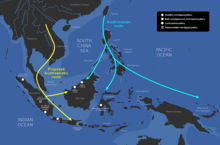
The
(3500 BCE–1200 CE)[41]
The most widespread migration event was the
The
]Early agricultural societies
Territorial principalities in both Insular and Mainland Southeast Asia, characterised as Agrarian kingdoms,
Intensive wet-rice cultivation in an ideal climate enabled the farming communities to produce a regular crop surplus that was used by the ruling elite to raise, command and pay work forces for public construction and maintenance projects such as canals and fortifications.[50][49]
Though
Bronze Age Southeast Asia

The earliest known evidence of copper and bronze production in Southeast Asia was found at
The Đông Sơn culture established a tradition of bronze production and the manufacture of evermore refined bronze and iron objects, such as plows, axes and sickles with shaft holes, socketed arrows and spearheads and small ornamented items.[58] By about 500 BCE, large and delicately decorated bronze drums of remarkable quality, weighing more than 70 kg (150 lb), were produced in the laborious lost-wax casting process. This industry of highly sophisticated metal processing was developed independent of Chinese or Indian influence. Historians relate these achievements to the presence of organized, centralized and hierarchical communities and a large population.[59]
Pottery culture

Between 1000 BCE and 100 CE, the Sa Huỳnh culture flourished along the south-central coast of Vietnam.[60] Ceramic jar burial sites that included grave goods have been discovered at various sites along the entire territory. Among large, thin-walled terracotta jars, ornamented and colorized cooking pots, glass items, jade earrings and metal objects were deposited near the rivers and along the coast.[61]
The Buni culture is the name given to another early independent centre of refined pottery production that has been well documented on the basis of excavated burial gifts, deposited between 400 BCE and 100 CE in coastal north-western Java.[62] The objects and artifacts of the Buni tradition are known for their originality and remarkable quality of incised and geometric decors.[63] Its resemblance to the Sa Huỳnh culture and the fact that it represents the earliest Indian Rouletted Ware recorded in Southeast Asia are subjects of ongoing research.[64]
Early historical era
Austronesian maritime trade network
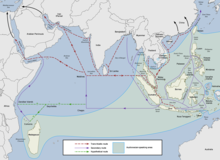
The first true maritime trade network in the
networks.In eastern
Indianised kingdoms
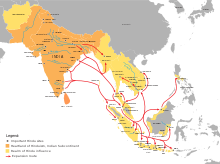
By around 500 BCE, Asia's expanding land and

The earliest Hindu kingdoms emerged in
The exact nature, process and extent of Indian influence upon the civilizations of the region is still fiercely debated by contemporary scholars. One such debate is over the extent to which Indian merchants, Brahmins, nobles or Southeast Asian mariner-merchants played central roles in bringing Indian conceptions to Southeast Asia. Additionally, the depth of the influence of Indian traditions is still contested. Whereas early 20th-century scholars emphasized the thorough Indianization of Southeast Asia, more recent authors have argued that Indian influence was much more limited, affecting only a small section of the elite.[79][80]
Maritime trade from China to India passed Champa and Funan at the
Numerous coastal communities in
Early relations with China
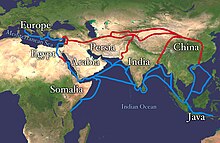
The earliest attested trading contacts in Southeast Asia were with the Chinese
Military conquests during the
Between the 2nd-century BCE and 15th-century CE, the
The Maritime Silk Road developed from the earlier
China later built its own fleets starting from the
Spread of Buddhism
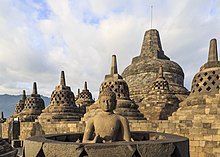

Local rulers benefited from the introduction of
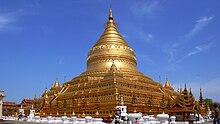
Between the 5th and the 13th century CE, Buddhism flourished in Southeast Asia. By the 8th century, the Buddhist
Medieval period

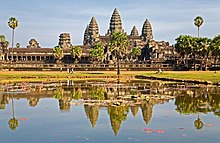
In
To the southeast of Sumatra, West Java was ruled by the Hindu Sunda Kingdom (c. 669–1579) after the fall of the Tarumanagara, while Central and East Java were dominated by a myriad of competing agrarian kingdoms including the Mataram Kingdom (716–929), Kediri (1052–1222), Singhasari (1222–1292), and Majapahit (1293–c. 1500). In the late 8th and early 9th centuries, the Śailendra dynasty that ruled the Mataram kingdom built a number of massive monuments in Central Java, including the Sewu and Borobudur Buddhist temples. According to the Deśavarṇana, an Old Javanese poem completed in 1365, vassal states of the Majapahit Empire spread throughout much of today's Indonesia, making it possibly the largest empire ever to exist in Southeast Asia, though the true character of its control over these territories is unclear.[95][96] The empire declined in the early 16th century after the rise of Islamic states in coastal Java, the Malay Peninsula, and Sumatra.

In the Philippines, the Laguna Copperplate Inscription dating from 900 CE is the earliest known calendar-dated document from the islands.[97] It relates a debt granted from a maginoo (royalty) who lived in the Tagalog city-state of Tondo which is now part of Manila area. The document mentions several contemporary states in the area, including Mataram Kingdom in Java.
The Khmer Empire covered much of mainland Southeast Asia from the early 9th until the 15th century, during which time a sophisticated architecture was developed, exemplified in the structures of the capital city Angkor. Situated in modern-day Vietnam, the kingdoms of Đại Việt and Champa were rivals to the Khmer Empire in the region. The Mon kingdom of Dvaravati was another major regional presence, first appearing in records around the 6th century CE. By the 10th century, however, Dvaravati had come under the influence of the Khmer. Nearby, Thai tribes conquered the Chao Phraya River valley of modern-day central Thailand around the 12th century and established the Sukhothai Kingdom in the 13th century and the Ayutthaya Kingdom in the 14th century.[98][99]
By the mid-16th century, the
Spread of Islam
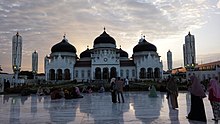
By the 8th century CE, less than 200 years after the
In addressing the issue of how Islam was introduced into Southeast Asia, historians have elaborated various routes from Arabia to India and then from India to Southeast Asia. Of these, two seem to take prominence: either Arabian traders and scholars who did not live or settle in India spread Islam directly to maritime Southeast Asia, or Arab traders that had been settling in coastal India and Sri Lanka for generations did. Muslim traders from India (Gujarat) and converts of South Asian descent are variously considered to play a major role.[110][111]
A number of sources propose the South China Sea as another route of Islamic introduction to Southeast Asia. Arguments for this hypothesis include the following:
- Extensive trade between Arabia and China before the 10th century is well documented and has been corroborated by archaeological evidence (see, for example, Belitung shipwreck).[112][113]
- During the Mongol conquest and the subsequent rule of the Yuan dynasty (1271–1368), hundreds of thousands of Muslims entered China. In Yunnan, Islam was propagated and commonly embraced.[114]
- Kufic grave stones in Champa, modern-day Vietnam, are indices of an early and permanent Islamic community in mainland Southeast Asia.[115][116][117]
- The founder of the Demak Sultanate in Java was of Sino-Javanese origin.[118][119]
- Hui mariner Zheng He proposed ancient Chinese architecture as the stylistic basis for the oldest Javanese mosques during his 15th-century visit to Demak, Banten, and the Red Mosque of Panjunan in Cirebon, West Java.[107]
In 2013, the European Union published the European Commission Forum, which maintains an inclusive attitude on the matter:[120]
Islam spread in Southeast Asia via Muslims of diverse ethnic and cultural origins, from Middle Easterners, Arabs and Persians, to Indians and even Chinese, all of whom followed the great commercial routes of the epoch.
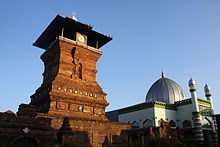
Unlike in other Islamic regions, Islam developed in Southeast Asia in a distinctly
There are various records of lay Muslim missionaries, scholars and mystics, particularly Sufis, who were active in peacefully proselytizing in Southeast Asia. Java, for example, received Islam by nine men, referred to as the "Wali Sanga" or "Nine Saints," although the historical identity of such people is almost impossible to determine. The foundation of the first Islamic kingdom in Sumatra, the Samudera Pasai Sultanate, took place during the 13th century.
The conversion of the remnants of the Buddhist
The idea of equality before God for the Ummah (the people of God) and a personal religious effort through regular prayer in Islam could have been more appealing than a perceived fatalism in Hinduism at the time.[123] However, Islam also taught obedience and submission, which could have helped guarantee that the social structure of a converted people or political entity saw less fundamental changes.[82]
Islam and its notion of exclusivity and finality is seemingly incompatible with other religions, including the Chinese concept of heavenly harmony and the Son of Heaven as its enforcer. The integration of the traditional East Asian tributary system with China at the centre Muslim Malays and Indonesians exacted a pragmatic approach of cultural Islam in diplomatic relations with China.[82]
Chinese treasure voyages

By the end of the 14th century,
Early modern era
European colonisation
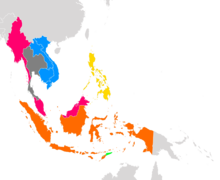
Legend:
France
Netherlands
Portugal
Spain
United Kingdom
The earliest
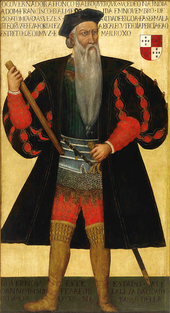
The British, in the guise of the
The British also temporarily possessed Dutch territories during the Napoleonic Wars; and Spanish areas in the Seven Years' War. In 1819, Stamford Raffles established Singapore as a key trading post for Britain in their rivalry with the Dutch. However, their rivalry cooled in 1824 when an Anglo-Dutch treaty demarcated their respective interests in Southeast Asia. British rule in Burma began with the first Anglo-Burmese War (1824–1826).
Early United States entry into what was then called the East Indies (usually in reference to the Malay Archipelago) was low key. In 1795, a secret voyage for pepper set sail from Salem, Massachusetts on an 18-month voyage that returned with a bulk cargo of pepper, the first to be so imported into the country, which sold at the extraordinary profit of seven hundred per cent.[129] In 1831, the merchantman Friendship of Salem returned to report the ship had been plundered, and the first officer and two crewmen murdered in Sumatra.
The
The United States does not hold any possessions in the East, nor does it desire any. The form of government forbids the holding of colonies. The United States therefore cannot be an object of jealousy to any Eastern Power. Peaceful commercial relations, which give as well as receive benefits, is what the President wishes to establish with Siam, and such is the object of my mission.[131]
From the end of the 1850s onwards, while the attention of the United States shifted to maintaining their union, the pace of European colonisation shifted to a significantly higher gear. This phenomenon, denoted New Imperialism, saw the conquest of nearly all Southeast Asian territories by the colonial powers. The Dutch East India Company and British East India Company were dissolved by their respective governments, who took over the direct administration of the colonies.

Only Thailand was spared the experience of foreign rule, though Thailand, too, was greatly affected by the power politics of the Western powers. The Monthon reforms of the late 19th Century continuing up till around 1910, imposed a Westernised form of government on the country's partially independent cities called Mueang, such that the country could be said to have successfully colonised itself.[132] Western powers did, however, continue to interfere in both internal and external affairs.[133][134]

By 1913, the British had occupied
Colonial rule had had a profound effect on Southeast Asia. While the colonial powers profited much from the region's vast resources and large market, colonial rule did develop the region to a varying extent. Commercial agriculture, mining and an export based economy developed rapidly during this period. The introduction Christianity bought by the colonist also have profound effect in the societal change.
Increased labour demand resulted in mass immigration, especially from
20th-century Southeast Asia
Japanese invasion and occupations

In September 1940, following the
Post-war decolonisation

With the rejuvenated nationalist movements in wait, the Europeans returned to a very different Southeast Asia after
During the
Following the independence of the
In 1975, Portuguese rule ended in East Timor. However, independence was short-lived as Indonesia annexed the territory soon after. However, after more than 20 years of fighting Indonesia, East Timor won its independence and was recognised by the UN in 2002. Finally, Britain ended its protectorate of the Sultanate of Brunei in 1984, marking the end of European rule in Southeast Asia.
Contemporary Southeast Asia


Modern Southeast Asia has been characterised by high economic growth by most countries and closer regional integration. Indonesia, Malaysia, the Philippines, Singapore and Thailand have traditionally experienced high growth and are commonly recognised as the more developed countries of the region. As of late, Vietnam too had been experiencing an economic boom. However, Myanmar, Cambodia, Laos and the newly independent East Timor are still lagging economically.
On 8 August 1967, the
See also
- Buddhism in Southeast Asia
- Hinduism in Southeast Asia
- Islam in Southeast Asia
- Greater India
- Two Layer hypothesis
- Spratly Islands
- History of Brunei
- History of Cambodia
- History of East Timor
- History of Indonesia
- History of Laos
- History of Malaysia
- History of Myanmar
- History of the Philippines
- History of Singapore
- History of Thailand
- History of Vietnam
- History of Asia
Notes
- Macaothe emporium for all foreign trade, and to receive all duties on imports; but, by a strange infatuation, the Portuguese government refused, and its decline is dated from that period. (Roberts, 2007 PDF image 173 p. 166)
- Republic of Taiwan (1895).
- statistical analysisof the relative economic prowess of the peoples there, giving special attention to the Chinese: The Chinese amount to 8595, and are landowners, field-labourers, mechanics of almost every description, shopkeepers, and general merchants. They are all from the two provinces of Canton and Fo-kien, and three-fourths of them from the latter. About five-sixths of the whole number are unmarried men, in the prime of life : so that, in fact, the Chinese population, in point of effective labour, may be estimated as equivalent to an ordinary population of above 37,000, and, as will afterwards be shown, to a numerical Malay population of more than 80,000! (Crawfurd image 48. p.30)
References
- ISBN 978-90-04-10512-6.
- ISBN 978-87-91114-60-1.
- ^ PMID 33753512.
- S2CID 237305537.
- ^ Hall, Kenneth R. A History of Early Southeast Asia: Maritime Trade and Societal Development, 100-1500.
- ^ doi:10.7152/bippa.v30i0.9966 (inactive 27 March 2024). Retrieved 12 February 2017.)
{{cite journal}}: CS1 maint: DOI inactive as of March 2024 (link - ^ "Chinese trade" (PDF). Britishmuseum.org. Archived (PDF) from the original on 9 October 2022. Retrieved 11 January 2017.
- ^ "Culture, Regionalism and Southeast Asian Identity" (PDF). Amitavacharya.com. Archived (PDF) from the original on 9 October 2022. Retrieved 8 January 2017.
- ^ Willem van Schendel. "Geographies of knowing, geographies of ignorance: jumping scale in Southeast Asia 2002 – Willem van Schendel Asia Studies in Amsterdam" (PDF). University of Amsterdam. Archived (PDF) from the original on 9 October 2022. Retrieved 8 February 2017.
- ISBN 978-0-521-54724-6.
- ISBN 9780195137989.
- ^ Muhamad Ali. Islam in Southeast Asia (Report). Oxford University Press. Retrieved 22 July 2017.
- ^ Thongchai Winichakul. "BUDDHISM AND SOCIETY IN SOUTHEAST ASIAN HISTORY" (PDF). University of Wisconsin-Madison. Archived from the original (PDF) on 4 December 2016. Retrieved 22 July 2017.
- ^ Constance Wilson. "Colonialism and Nationalism in Southeast Asia". Center for Southeast Asian Studies, Northern Illinois University. Retrieved 9 March 2018.
- ^ "S-E Asia's identity long in existence". Hartford-hwp com. Retrieved 8 January 2017.
- ^ "SOVEREIGNTY AND THE STATE IN ASIA: THE CHALLENGES OF THE EMERGING INTERNATIONAL ORDER" (PDF). University of Chicago. Archived (PDF) from the original on 9 October 2022. Retrieved 13 January 2018.
- ^ "Revisiting the "Lands Below the Winds"". Library.ucla.edu. Retrieved 8 February 2017.
- ISBN 978-81-207-4910-8.
- . Retrieved 9 March 2018.
- ^ Eliot, Joshua; Bickersteth, Jane; Ballard, Sebastian (1996). Indonesia, Malaysia & Singapore Handbook. New York City: Trade & Trade & Travel Publications.
- ^ OOI KEAT GIN. "SOUTHEAST ASIA a Historical Encyclopedia, from Angkor Wat to East Timor 2004" (PDF). Library of Congress. Archived (PDF) from the original on 9 October 2022. Retrieved 8 February 2017.
- ISBN 978-1-119-25154-5.
- ^ "Results of New Research at La-ang Spean Prehistoric Site" (PDF). dccam org. Retrieved 2 January 2017.
- ^ "Malaysian scientists find stone tools 'oldest in Southeast Asia'". Agence France-Presse. 31 January 2009. Archived from the original on 18 February 2014. Retrieved 2 January 2017.
- ^ Swisher 1994; Dennell 2010, p. 262.
- ^ Dennell 2010, p. 266, citing Morwood 2003
- ^ Kiona N. Smith (11/9/2018) What the world’s oldest figurative drawing reveals about human migration
- S2CID 4302539.
- PMID 28074030.
- ^ "Oldest bones from modern humans in Asia discovered". CBSNews. 20 August 2012. Retrieved 21 August 2016.
- PMID 25849125.
- PMID 34433944.
- qpGraphanalysis confirmed this branching pattern, with the Leang Panninge individual branching off from the Near Oceanian clade after the Denisovan gene flow, although with the most supported topology indicating around 50% of a basal East Asian component contributing to the Leang Panninge genome (Fig. 3c, Supplementary Figs. 7–11).
- PMID 17161859.
- ^ Charles Higham. "Hunter-Gatherers in Southeast Asia: From Prehistory to the Present". Digitalcommons. Retrieved 2 January 2017.
- ^ "The Tabon Cave Complex and all of Lipuun – UNESCO World Heritage Centre". Whc.unesco.org. Retrieved 22 February 2017.
- .
- . Retrieved 2 January 2017.
- ISBN 9781760460952.
- ISBN 978-0-521-66369-4.
- ISBN 978-0-470-01590-2.
- ^ "THE AUSTRONESIAN SETTLEMENT OF MAINLAND SOUTHEAST ASIA" (PDF). Sealang. Archived (PDF) from the original on 9 October 2022. Retrieved 2 January 2017.
- PMID 25137359.
- ^ "Austronesian Southeast Asia: An outline of contemporary issues". Omnivoyage. Retrieved 2 January 2017.
- ^ "Origins of Ethnolinguistic Identity in Southeast Asia" (PDF). Roger Blench. Archived (PDF) from the original on 9 October 2022. Retrieved 2 January 2017.
- ISBN 9780858836389. Archived(PDF) from the original on 9 October 2022.
- (PDF) from the original on 9 October 2022.
- ISBN 978-0-691-15626-2.
- ^ ISBN 978-94-009-8896-5.
- ^ a b "Pre-Angkorian Settlement Trends in Cambodia's Mekong Delta and the Lower Mekong" (PDF). Anthropology.hawaii.edu. Archived from the original (PDF) on 23 September 2015. Retrieved 11 February 2017.
- ^ "Early Mainland Southeast Asian Landscapes in the First Millennium" (PDF). Anthropology.hawaii.edu. Archived (PDF) from the original on 9 October 2022. Retrieved 12 February 2017.
- .
- ^ Tsang, Cheng-hwa (2000), "Recent advances in the Iron Age archaeology of Taiwan", Bulletin of the Indo-Pacific Prehistory Association, 20: 153–158, doi:10.7152/bippa.v20i0.11751
- ^ Turton, M. (2021). Notes from central Taiwan: Our brother to the south. Taiwan’s relations with the Philippines date back millenia, so it’s a mystery that it’s not the jewel in the crown of the New Southbound Policy. Taiwan Times.
- ^ Everington, K. (2017). Birthplace of Austronesians is Taiwan, capital was Taitung: Scholar. Taiwan News.
- ^ Bellwood, P., H. Hung, H., Lizuka, Y. (2011). Taiwan Jade in the Philippines: 3,000 Years of Trade and Long-distance Interaction. Semantic Scholar.
- S2CID 162300712. Retrieved 11 February 2017 – via Researchgate.net.
- ^ Daryl Worthington (1 October 2015). "How and When the Bronze Age Reached South East Asia". New Historian. Retrieved 9 March 2018.
- ^ "history of Southeast Asia". Encyclopædia Britannica. Retrieved 11 February 2017.
- Sa Huỳnhculture in Thu Bồn Valley (Reinecke et al. 2002, 153–216); 2) Lai Nghi is a prehistoric cemetery richly equipped with iron tools and weapons, ..."
- ^ Ian Glover; Nguyễn Kim Dung. Excavations at Gò Cầm, Quảng Nam, 2000–3: Linyi and the Emergence of the Cham Kingdoms. Academia.edu. Retrieved 12 February 2017.
- ^ Zahorka, Herwig (2007). The Sunda Kingdoms of West Java, From Tarumanagara to Pakuan Pajajaran with Royal Center of Bogor, Over 1000 Years of Propsperity and Glory. Yayasan cipta Loka Caraka.
- ISBN 978-981-4345-10-1.
- ISBN 978-9971-69-351-0.
- ^ ISBN 9783319338224.
- ^ Doran, Edwin Jr. (1974). "Outrigger Ages". The Journal of the Polynesian Society. 83 (2): 130–140.
- ^ ISBN 978-0415100540.
- ISBN 9780890961070.
- ^ Blench, Roger (2004). "Fruits and arboriculture in the Indo-Pacific region". Bulletin of the Indo-Pacific Prehistory Association. 24 (The Taipei Papers (Volume 2)): 31–50.
- ^ ISBN 9780195300307.
- ISBN 9781880188057.
- S2CID 161331467.
- ISBN 978-0-8248-0843-3.
- ^ National Library of Australia. Asia's French Connection : George Coedes and the Coedes Collection Archived 21 October 2011 at the Wayback Machine
- ^ "Southeast Asia: Imagining the region" (PDF). Amitav Acharya. Archived (PDF) from the original on 9 October 2022. Retrieved 13 January 2018.
- ISBN 978-1-285-78308-6.
- ^ "The Mon-Dvaravati Tradition of Early North-Central Thailand". The Metropolitan Museum of Art. Retrieved 15 December 2009.
- .
- ^ "Hinduism in Southeast Asia". oxford press. 28 May 2013. Retrieved 20 December 2016.
- ^ "Hinduism and Buddhism in Southeast Asia by Monica Sar on Prezi". prezi.com. Retrieved 20 February 2017.
- ^ Helmut Lukas. "THEORIES OF INDIANIZATION Exemplified by Selected Case Studies from Indonesia (Insular Southeast Asia)" (PDF). Österreichische Akademie der Wissenschaften. Archived from the original (PDF) on 15 December 2017. Retrieved 14 January 2018.
- ^ a b c d "A Short History of China and Southeast Asia.pdf – A Short History of Asia" (PDF). Docs8.minhateca.com. Archived (PDF) from the original on 9 October 2022. Retrieved 4 February 2017.
- ISBN 978-0710311672.
- ^ "Maritime Silk Road". SEAArch.
- ^ a b c d Guan, Kwa Chong (2016). "The Maritime Silk Road: History of an Idea" (PDF). NSC Working Paper (23): 1–30. Archived (PDF) from the original on 9 October 2022.
- ISBN 9781588395245.
- S2CID 140665305.
- ^ Donald K. Swearer. "The Buddhist World of Southeast Asia" (PDF). Suny Press. Archived from the original (PDF) on 16 March 2015. Retrieved 20 February 2017.
- ISSN 1749-8171.
- ^ "EXPANSION OF BUDDHISM INTO SOUTHEAST ASIA" (PDF). Unesco. Archived (PDF) from the original on 9 October 2022. Retrieved 2 January 2017.
- ISBN 9781462906994.
- ISBN 978-1-4381-0996-1.
- ^ "The Buddhist World: Buddhism in Southeast Asia: Burma, Thailand, Cambodia, Laos, Vietnam, Indonesia". buddhanet.net. Retrieved 14 January 2018.
- ^ "Śrīvijaya towards Chaiya ー The History of Srivijaya". NTT Plala Inc. Retrieved 10 March 2018.
- ^ Robson, Stuart (1995). Deśawarṇana (Nāgarakṛtāgama) by Mpu Prapañca. Leiden: KITLV Press.
- ^ Sastrawan, Wayan Jarrah (9 January 2020). "Was Majapahit Really an Empire". New Mandala. Retrieved 10 January 2024.
- .
- S2CID 165680758.
- ^ "A Short History of South East Asia Chapter 3. The Repercussions of the Mongol Conquest of China ...The result was a mass movement of Thai peoples southwards..." (PDF). Stanford University. Archived (PDF) from the original on 9 October 2022. Retrieved 11 March 2018.
- ISBN 978-1-4008-5585-8.
- ^ Lieberman 2003. pp. 151–152.
- ^ Lieberman 2003: 151–152
- ^ "THAI-BURMESE WARFARE DURING THE SIXTEENTH CENTURY AND THE GROWTH OF THE FIRST TOUNGOO EMPIRE" (PDF). p. 78. Archived (PDF) from the original on 9 October 2022.
- ^ "Min-gyi-nyo, the Shan Invasions of Ava (1524-27), and the Beginnings of Expansionary Warfare in Toungoo Burma: 1486-1539" (PDF). pp. 379–382. Archived (PDF) from the original on 9 October 2022.
- ^ Burmese Administrative Cycles: Anarchy and Conquest, c.1580-1760. p. 27.
- ^ Burmese Administrative Cycles: Anarchy and Conquest, c. 1580-1760. pp. 27–28.
- ^ a b Wahby, Ahmed E I (April 2008). "The Architecture of the Early Mosques and Shrines of Java: Influences of the Arab Merchants in the 15th and 16th Centuries?". Retrieved 4 February 2017.
- ^ "Islam: Islam in Southeast Asia – Dictionary definition of Islam: Islam in Southeast Asia". Encyclopedia.com. Retrieved 30 January 2017.
- ^ "Islam, The Spread of Islam To Southeast Asia". History-world.org. Archived from the original on 8 November 2018. Retrieved 30 January 2017.
- ^ A History of Islam in the Malay-Indonesian World: between Acculturation and Rigor. Academia.edu. Retrieved 4 February 2017.
- ^ "Introduction to Southeast Asia – The Arrival of Islam in Southeast Asia". Asia Society. Retrieved 13 January 2018.
- ^ "Made in China – National Geographic Magazine". Archived from the original on 1 September 2009. Retrieved 4 February 2017.
- ^ "Press Room". Asia.si.edu. Archived from the original on 6 June 2011. Retrieved 4 February 2017.
- ^ "An Earlier Age of Commerce in Southeast Asia : 900–1300 C.E." (PDF). Helsinki.fi. Archived (PDF) from the original on 9 October 2022. Retrieved 4 February 2017.
- ^ "Gravestone – Collections – Antiquities Museum". Antiquities.bibalex.org. Archived from the original on 18 May 2013. Retrieved 4 February 2017.
- ^ "Signatures on gravestones: two XII century Iranian tombstones". squarekufic. 18 October 2014. Retrieved 4 February 2017.
- ISBN 978-981-230-837-5.
- ^ Qurtuby, Sumanto Al. "Cheng Ho and the History of Chinese Muslims in Java". Academia.edu. Retrieved 4 February 2017.
- ISBN 978-981-230-837-5.
- ^ "International research update 62" (PDF). Ec.europa.eu. Archived (PDF) from the original on 9 October 2022. Retrieved 4 February 2017.
- ^ Bruinessen, Martin van (January 2014). "Ghazwul fikri or Arabisation? Indonesian Muslim responses to globalisation". In: Ken Miichi and Omar Farouk (Eds), Southeast Asian Muslims in the Era of Globalization, Palgrave Macmillan, 2014, Pp. 61-85. Academia.edu. Retrieved 4 February 2017.
- ^ Thompson, Gavin; Lunn, Jon (14 December 2011). Southeast Asia: A political and economic introduction – Commons Library briefing – UK Parliament (Report). Researchbriefings.parliament.uk. Retrieved 4 February 2017.
- JSTOR 3316807.
- ^ "The Ming Voyages". Columbia University. Retrieved 25 March 2018.
- ^ "Zheng He – Chinese Admiral in the Indian Ocean". Khan Academy. Retrieved 25 March 2018.
- ^ Thomas Wright. "The Travels of Marco Polo, the Venetian – Book III" (PDF). Public Library UK. Archived (PDF) from the original on 9 October 2022. Retrieved 25 March 2018.
- ^ "Niccolò dei Conti". Encyclopaedia Britannica. Retrieved 25 March 2018.
- OCLC 03452414. Retrieved 10 February 2014.
- OCLC 4669778.
When Captain Jonathan Carnes set sail. ...
- OCLC 12212199.)
Having some years since become acquainted with the commerce of Asia and Eastern Africa, the information produced on my mind a conviction that considerable benefit would result from effecting treaties with some of the native powers bordering on the Indian ocean.
{{cite book}}: CS1 maint: numeric names: authors list (link - ^ "1b. Harris Treaty of 1856" (exhibition). Royal Gifts from Thailand. National Museum of Natural History. 14 March 2013 [speech delivered 1856]. Retrieved 9 February 2014.
- ^ Murdoch, John B. (1974). "The 1901–1902 Holy Man's Rebellion" (PDF). Journal of the Siam Society. JSS Vol.62.1e (digital). Siam Heritage Trust: 38. Archived (PDF) from the original on 9 October 2022. Retrieved 2 April 2013.
.... Prior to the late nineteenth century reforms of King Chulalongkorn, the territory of the Siamese Kingdom was divided into three administrative categories. First were the inner provinces which were in four classes depending on their distance from Bangkok or the importance of their local ruling houses. Second were the outer provinces, which were situated between the inner provinces and further distant tributary states. Finally there were the tributary states which were on the periphery....
- ^ de Mendonha e Cunha, Helder (1971). "The 1820 Land Concession to the Portuguese" (PDF). Journal of the Siam Society. JSS Vol. 059.2g (digital). Siam Society. Archived (PDF) from the original on 9 October 2022. Retrieved 6 February 2014.
It was in Ayudhya that Portugal had its first official contact with the Kingdom of Siam, in 1511.
- ^ Oblas, Peter B. (1965). "A Very Small Part of World Affairs" (PDF). Journal of the Siam Society. JSS Vol.53.1e (digital). Siam Society. Archived (PDF) from the original on 9 October 2022. Retrieved 7 September 2013.
Negotiations 1909–1917. On the 8th of August 1909, Siam's Adviser in Foreign Affairs presented a proposal to the American Minister in Bangkok. The Adviser, Jens Westengard, desired a revision of the existing extraterritorial arrangement of jurisdictional authority. ...
- ^ Vichy versus Asia: The Franco-Siamese War of 1941
- ^ Tom G. Hoogervorst. "Some reflections on Southeast Asia and its position in academia" (PDF). Project Southeast Asia. Archived (PDF) from the original on 9 October 2022. Retrieved 14 January 2018.
- ^ Frey, Rebecca Joyce (2009). Genocide and International Justice.
- ^ Olson, James S.; Roberts, Randy (2008). Where the Domino Fell: America and Vietnam 1945–1995 (5th ed.). Malden, Massachusetts: Blackwell Publishing
Bibliography
- ISBN 978-90-481-9036-2.
- S2CID 55510294. Archived from the originalon 10 March 2014. Retrieved 10 March 2014..
- Swisher, C. C. (1994). "Age of the earliest known hominin in Java, Indonesia". Science. 263 (5150): 1118–21. PMID 8108729.
- Sinha, P.C. , ed. Encyclopaedia of South East and Far East Asia (Anmol, 2006).
Further reading
- Reid, Anthony. A History of Southeast Asia: Critical Crossroads (Blackwell History of the World, 2015)
- Charles Alfred Fisher (1964). South-east Asia: a social, economic, and political geography. Methuen. ISBN 9789070080600.
- D.G.E. Hall (1981). A History of South-East Asia 4th ed. online version of 1955 edition, 810pp
- ISBN 978-0-8248-0368-1.
- Lokesh, Chandra, & International Academy of Indian Culture. (2000). Society and culture of Southeast Asia: Continuities and changes. New Delhi: International Academy of Indian Culture and Aditya Prakashan.
- Daigorō Chihara (1996). Hindu-Buddhist Architecture in Southeast Asia. BRILL. ISBN 978-90-04-10512-6.
- Peter Church (3 February 2012). A Short History of South-East Asia. John Wiley & Sons. ISBN 978-1-118-35044-7.
- George Cœdès (1968). The Indianized States of South-East Asia. University of Hawaii Press. ISBN 978-0-8248-0368-1.
- Embree, Ainslie T., ed. Encyclopedia of Asian history (1988)
- von Glahn, Richard (27 December 1996). Fountain of Fortune: Money and Monetary Policy in China, 1000-1700. University of California Press. ISBN 978-0-520-91745-3.
- Bernard Philippe Groslier (1962). The art of Indochina: including Thailand, Vietnam, Laos and Cambodia. Crown Publishers.
- Kenneth R. Hall (28 December 2010). A History of Early Southeast Asia: Maritime Trade and Societal Development, 100–1500. Rowman & Littlefield Publishers. ISBN 978-0-7425-6762-7.
- ISBN 978-0-521-29137-8.
- Virginia Matheson Hooker (2003). A Short History of Malaysia: Linking East and West. Allen & Unwin. ISBN 978-1-86448-955-2.
- Michael C. Howard (23 February 2012). Transnationalism in Ancient and Medieval Societies: The Role of Cross-Border Trade and Travel. McFarland. ISBN 978-0-7864-9033-2.
- Victor T. King (2008). The Sociology of Southeast Asia: Transformations in a Developing Region. NIAS Press. ISBN 978-87-91114-60-1.
- Paul Michel Munoz (2006). Early Kingdoms of the Indonesian Archipelago and the Malay Peninsula. National Book Network. ISBN 978-981-4155-67-0.
- D. R. SarDesai (2003). Southeast Asia, Past and Present. Westview Press. ISBN 978-0-8133-4143-9.
- Heidhues, Mary Somer. "'Southeast Asia: A Concise History" ISBN 0-500-28303-6
- ISBN 978-81-7018-046-3.
- Ooi, Keat Gin, ed. (2004). Southeast Asia: A Historical Encyclopedia, from Angkor Wat to East Timor, Volume 1 (illustrated ed.). ABC-CLIO. ISBN 978-1576077702. Retrieved 24 April 2014.
- Guy, John (1986). Guy, John (ed.). Oriental trade ceramics in South-East Asia, ninth to sixteenth centuries: with a catalogue of Chinese, Vietnamese and Thai wares in Australian collections (illustrated, revised ed.). Oxford University Press. ISBN 9780195825930.
- David G. Marr; Anthony Crothers Milner (1986). Southeast Asia in the 9th to 14th Centuries. Institute of Southeast Asian Studies. ISBN 978-9971-988-39-5.
- Osborne, Milton. Southeast Asia. An introductory history. ISBN 1-86508-390-9
- Jan M. Pluvier (1995). Historical Atlas of South-East Asia. E.J. Brill. ISBN 978-90-04-10238-5.
- ISBN 978-0-300-04750-9.
- Anthony Reid (1 August 2000). Charting the Shape of Early Modern Southeast Asia. Silkworm Books. ISBN 978-1-63041-481-8.
- Scott, James C., The Art of Not Being Governed: An Anarchist History of Upland Southeast Asia (Yale Agrarian Studies Series), 464 pages, Yale University Press (30 September 2009), ISBN 978-0300152289
- Tarling, Nicholas (ed). The Cambridge history of Southeast Asia Vol I-IV. ISBN 0-521-66369-5
- R. C. Majumdar, Study of Sanskrit in South-East Asia
- ISBN 81-7018-046-5.
- Paul Michel Munoz (2006). Early Kingdoms of the Indonesian Archipelago and the Malay Peninsula. Editions Didier Millet. ISBN 978-981-4155-67-0.
- Reid, Anthony (1993). Southeast Asia in the Age of Commerce, 1450-1680: Expansion and crisis, Volume 2. Vol. 2 of Southeast Asia in the Age of Commerce, 1450–1680 (illustrated ed.). Yale University Press. ISBN 978-0300054125. Retrieved 24 April 2014.
- Reid, Anthony; Alilunas-Rodgers, Kristine, eds. (1996). Sojourners and Settlers: Histories of Southeast China and the Chinese. Contributor Kristine Alilunas-Rodgers (illustrated, reprint ed.). University of Hawaii Press. ISBN 978-0824824464. Retrieved 24 April 2014.
- Edward H. Schafer (1963). The Golden Peaches of Samarkand: A Study of Tʻang Exotics. University of California Press. GGKEY:XZ70D3XUH9A.
- Paz, Victor; Solheim, II, Wilhelm G., eds. (2004). Southeast Asian Archaeology: Wilhelm G. Solheim II Festschrift (illustrated ed.). University of the Philippines Press. ISBN 978-9715424516. Retrieved 24 April 2014.
- Yule, Paul. The Bronze Age Metalwork of India. Prähistorische Bronzefunde XX,8, Munich, 1985, ISBN 3 406 30440 0.
- Demeter, F.; Shackelford, L. L.; Bacon, A.-M.; Duringer, P.; Westaway, K.; Sayavongkhamdy, T.; Braga, J.; Sichanthongtip, P.; Khamdalavong, P.; Ponche, J.-L.; Wang, H.; Lundstrom, C.; Patole-Edoumba, E.; Karpoff, A.-M. (20 August 2012). "Anatomically modern human in Southeast Asia (Laos) by 46 ka". Proceedings of the National Academy of Sciences. 109 (36): 14375–14380. PMID 22908291.
- Marwick, Ben (January 2008). "Stone artefacts and recent research in the archaeology of mainland Southeast Asian hunter-gatherers". Before Farming. 2008 (4): 1–19. .
- The South East Asian Review. Institute of South East Asian Studies. 1995.
- Southeast Asia. Lonely Planet. 15 September 2010. ISBN 978-1-74220-377-5.
- Tri thức Đông Nam Á. Nhà xuá̂t bản Chính trị quó̂c gia. 2008. pp. 208–.
- Thailandia. Touring Editore. 2005. ISBN 978-88-365-3327-5.
